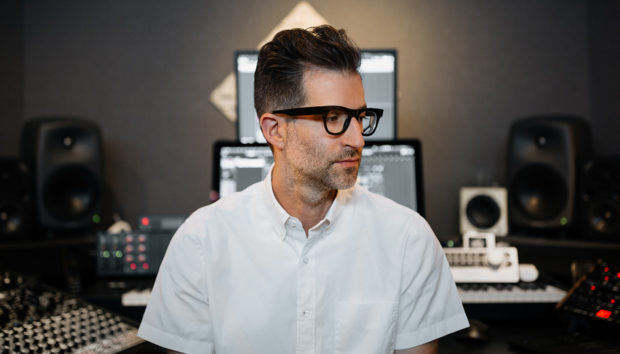Berlin-based Angus Finlayson, aka Minor Science, has been turning heads and catching ears on the electronic music scene since 2014, when his cerebral debut EP, Noble Gas, was released to broad acclaim by press and public alike. Three singles followed, and April 2020 at last saw the launch of the first Minor Science album, Second Language, a genuinely eclectic mélange of house, techno, breakbeat, IDM and other contemporary flavors that impresses with both its technicality and soul – highly recommended listening from the bleeding edge of electronica.
For his contribution to our ongoing Patch and Play series of artist presets for MASSIVE X, Angus has come up with a wildly animated, willfully unpredictable patch geared up to provide inspirational source material for more abstract production styles. A cascading series of randomized filter-modulating LFOs simulate step sequencing and lay intriguing rhythmic and tonal foundations, while ten thoughtfully assigned Macros enable easy transformation of the sound from retro sci-fi burbling to heavily distorted noisescape and everything in between. Indeed, this is the kind of patch that positively invites user input, and getting hands-on with those Macros via your KOMPLETE KONTROL keyboard or other MIDI controller is key to realizing its real-time potential.
Hear the patch being put through its paces below, download it for free here, and read on to learn how Angus approached the design and construction of this quirky MASSIVE X curio and get some horse’s-mouth guidance on using it.
Describe your first experience with MASSIVE X. Did you use the original MASSIVE much?
I never used the original, but was aware of it, mostly through its use in dubstep, which I was very into in the late noughties. On firing up MASSIVE X for the first time, it became immediately apparent that it could do a million things other than gnarly basses and leads.
Tell us about how you approached making this patch – what was your initial goal, and what were the main parameters and techniques you used?
The patch came about almost accidentally, while I was finding my way around the synth. I often end up making generative patches when playing around with new kit – by making tools ‘play themselves’, I can get a feel for their range and quirks. I was experimenting with using the filter as an oscillator, and with the ridiculously extensive LFO features. Once I realized I had the seed of something interesting, I began to think of the patch as an instrument to be played, and focused on adding layers that would broaden its expressive possibilities without making it too formless.
In my own work, I’ll use a patch like this as a sound generator: I’ll start recording in an empty project, make a bunch of sounds with it, then save them as audio to be used in tracks later. It’s more a source, not something you could drop into an ongoing track; it’s too unpredictable for that.
There’s a lot of movement in the patch, to the point that it sounds sequenced, yet you haven’t used the Performers at all. How did you achieve this effect?
It’s all about the randomized LFOs. I’ll often assign a random-waveform LFO to control the rate of another random-waveform LFO. This second layer of randomness gives the sound a feeling of autonomy – you can’t detect a regular pattern behind it.
With MASSIVE X, the flexible assignment options mean I could do this in circuit: LFO 4 controls the rate of LFO 6, LFO 6 the rate of LFO 5, and LFO 5 controls LFO 4. In this way, their behavior starts to feel coherent but impossible to predict. Then it’s just a case of controlling the range of behavior – the Macros do this – to produce results within a desired spectrum.
Tell us more about the Macros assignments in the patch – you’ve certainly made extensive use of them.
It’s a bit fiddly, so bear with me…
‘Density’ controls the overall range of the Rate controls on a bunch of the other LFOs. When it’s turned up, the LFOs controlling the filter, FX, etc, tend to tick faster, spitting out more musical information in a given time.
‘Pitch’ controls the range of frequencies hit by the self-oscillating filter. Higher ‘pitch’ knob, higher-frequency sounds.
‘Air’ controls the amount of noise input going into the filter, which alters the sound. The lowest setting still sends through a tiny bit of noise, as I found this was necessary to get sound out of the self-oscillating filter.
The three ‘timbre’ macros control a randomized distortion, two differently randomized bit-crushers, and the filter’s FM knob, respectively. They interact in pretty unpredictable ways, so it’s worth trying different configurations.
‘Titeverb’, ‘dly’ and ‘longverb’ control the mix levels of three randomized spatial effects. And ‘space’ controls their size in the case of the reverbs, or feedback in the case of the delay. More ‘space’, bigger sound.
Do presets play a role in your music making?
Yes, a huge one! I feel no shame about working from factory presets: building a patch from scratch every time is terrible for creative flow. While working on my album, I also became systematic about making and storing my own presets. I don’t always feel inspired to write a melody or whatever, so this kind of ‘behind-the-scenes’ work – exploring, developing and archiving material for later use – can fill those less inspired days, and set things up nicely for when the muse comes back.
Do you have any advice for musicians wanting to design their own sounds?
I think that the tools you use suggest the sounds you come up with, rather than the producer plucking them out of thin air. The interface of a plugin or some particular feature of an outboard synth might suggest an idiosyncratic way of doing things, which leads to certain sonic results. But that doesn’t mean you need expensive kit to make cool sounds!













